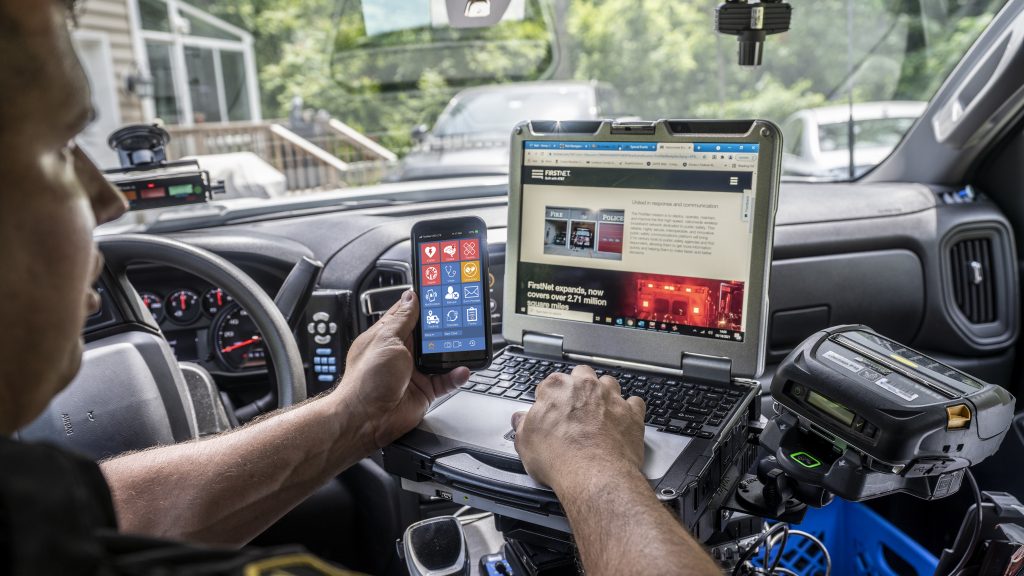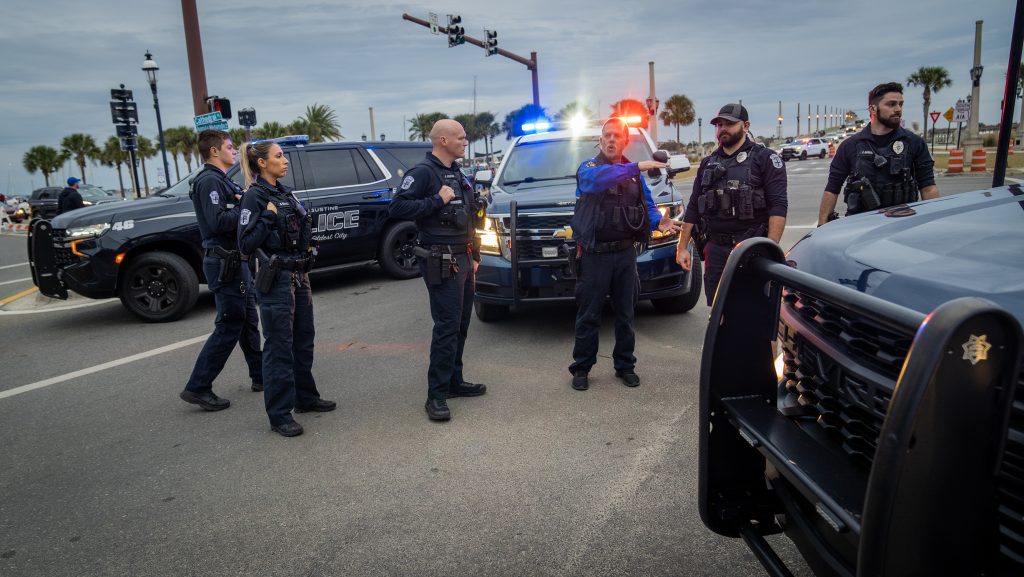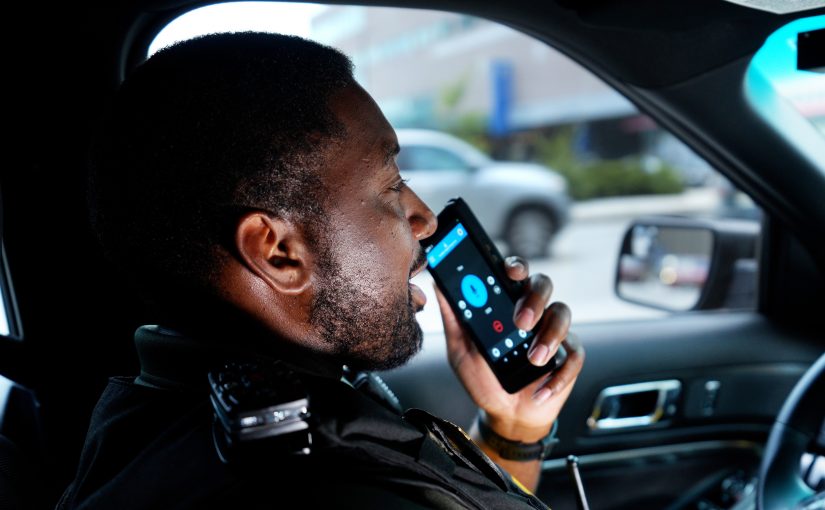In a world of connected and mobile devices where the possession of a smart device is becoming the norm, not the exception, a connected, mobile police force is the way forward. Many police agencies are already exploring ways to integrate mobile broadband technologies to help officers operate more safely, efficiently, and effectively.
The Los Angeles, California, Police Department (LAPD) is embracing this idea wholeheartedly, having already issued mobile devices as a standard part of any officer’s toolkit. The idea is to treat a mobile device as essential, just like an officer’s radio, gun, or handcuffs. This is part of a “mobile-first mindset” where communications, operations, and services are integrated with mobile devices and their capabilities. The LAPD has a long-term goal of achieving a mobile-only approach to communications.
Untethering the Workforce
The LAPD Information Technology Bureau is responsible for leading the department’s technology initiatives, including integrating mobile technologies into daily operations.
The LAPD chose FirstNet to connect its mobile technologies because FirstNet is the U.S. broadband network dedicated to public safety.1 Overseen by the First Responder Network Authority (FirstNet Authority), an independent authority within the U.S. Department of Commerce, the network was built in a public-private partnership with AT&T to serve the needs of public safety.2
Because the network was designed by first responders for first responders, it has unique features and capabilities specifically tailored to public safety needs, including priority and preemption. Priority ensures that first responder communications always get first access to the network. Preemption ensures that first responders stay connected, even when commercial networks get congested or overwhelmed.3
These features, along with extensive coverage, mean officers can stay connected across the city. As a result, the LAPD began transitioning from radios and mobile data terminals (MDTs) to smartphones and tablets.
In 2022, the LAPD announced it had equipped every officer with a smartphone operating on FirstNet.4 The department also outfitted its patrol vehicles with routers to provide connectivity for officers in the field; these routers also operate on FirstNet. The department saw these technologies quickly adopted and embraced. Following that initial success, the department is now rolling out upgraded smartphone devices to its officers.
The Benefits of Mobility
Law enforcement is becoming increasingly mobile and virtual, and this “untethering” of the workforce offers numerous benefits, many of which will have lasting impacts on police work.
- Strengthened relationships with the community: Using mobile devices with capabilities like voice-to-text or autofill digital forms, officers can complete paperwork in the field rather than returning to headquarters. Ultimately, this means officers can spend more time in the community—a primary goal of a mobile-first strategy. The more time spent in the community, the more opportunities officers have to make vital connections and build trust with the people they serve.
- Real-time data sharing: Mobile devices offer the ability to capture and share information in real time, speeding up information sharing and improving officers’ situational awareness. Additionally, this approach allows the capture of information that would otherwise stay in the field or be delayed in documenting, potentially jeopardizing reporting and use for evidentiary purposes. This in-the-moment data sharing is becoming integral to daily operations. For example, LAPD motorcycle officers are equipped with tablets integrated with computer-aided dispatch, meaning they no longer need to radio in requests for information but can look it up themselves. Several officers have said they would rather call in sick than operate without their tablet. Another benefit is during disaster recovery, when real-time data sharing expedites the process of receiving funding from the state or federal government. Geolocation tools can help provide a more accurate picture of resources used and recoup those costs more quickly and efficiently.
- Enhanced officer safety: Mobile technology makes officers’ jobs safer. Mobile apps allow for greater resource tracking, including pinpointing the actual location of personnel, not just their vehicles. Incident commanders can keep an eye on where their officers are and redirect other units to provide backup when needed. An unexpected way that mobile devices are improving officer safety is in patrol vehicles. Tablets don’t require the bulky mounts that MDTs do. This metal infrastructure has been the cause of many officer injuries and even deaths during collisions. As the LAPD transitions from MDTs to mobile devices that integrate with in-vehicle mirroring technology, this change will improve officer safety inside in their own vehicles.
- Recruiting the next generation of officers: Gen Z is entering the workforce fully expecting mobile technology to be part of their toolset, just as it is in their personal lives. Investing in mobile technology assures younger officers that the department is investing in them. The same rule of thought applies to the community—the public does not want officers to show up to an incident with carbon copy paper. They expect modern technology to be used for efficient policing.
- Cross-generational collaboration: While younger officers may intuitively understand technology, older officers may not. The LAPD has seen these diverse experiences translate into stronger bonds between generations. In many cases, younger officers are training older officers on ways to use technology to improve their operations. This creates a level of trust and camaraderie that cannot be engineered.
- Credentialing and security: A typical day for a police officer often starts with logging on to a series of apps, devices, and databases. With different usernames, forgotten passwords, and multifactor authentication, this process can take up to 15 minutes just to get started. With a unified mobile platform, officers can access multiple resources with a single sign-on. This identity, credential, and access management (ICAM) solution allows for a faster, more secure log on for frontline officers.5
A Path to Mobility: 10 Tips for Getting Started
The LAPD is a leader in innovative policing technology, and their success is built on years of lessons learned from technology implementations.
Beyond building a network designed for public safety, the FirstNet Authority focuses on bringing new solutions that solve public safety’s communication needs.
These partners’ collective experience have been distilled into the following 11 recommendations for successfully implementing a mobile-first strategy.
1. Do the research and make a plan. When exploring a mobile strategy, the LAPD’s Information Technology Bureau researched capabilities, identified needs, and created a comprehensive plan. It’s recommended that agencies map out a solution’s capabilities against their desired outcomes.
-
- Assess whether the technology aims to enhance officer safety, improve response times, strengthen community relations, improve communications, address specific crime issues, or achieve other specific goals
- Research the solutions’ capabilities and limitations.
- Ensure the technology can adapt to evolving agency needs and integrate with existing systems.

2. Set the guardrails with strong governance. A strategic framework is essential for guiding technology integration. When implementing the strategic framework, leaders should think about policy development, governance structures, and performance metrics. This approach ensures the technology adoption is systematic, transparent, and aligned with the organization’s mission.
-
- Establish committees or task forces that include command staff, IT professionals, and frontline officers to oversee technology implementation, create policies, and meet agency objectives.
- Create comprehensive policies that govern the ethical use of technology and address privacy concerns, data security, and appropriate usage to maintain public trust.
- Develop criteria and a process to document and evaluate the effectiveness of the technology in meeting the defined objectives, allowing for continuous improvement and accountability.
3. Get stakeholder buy-in early. When considering new technology, get input early in the process from diverse stakeholders. The LAPD is governed by a board of police commissioners that is composed of community leaders. When a mobile-first plan was in development, the LAPD had preliminary discussions with the board about the potential, the opportunities, and the concerns. Having this buy-in was key to getting the program launched.
-
- Involve personnel from different levels within the agency to ensure the technology addresses real-world challenges faced by officers.
- Consult with community leaders, including elected officials, prosecutors, courts, community organizations, and other criminal justice agencies.
- Socialize the plan with entities that have oversight and governance of the agency.
4. Be explicit about what is needed. The vendor is looking to agency leaders to dictate their needs. If an organization doesn’t ask for something, it may not be provided or they may end up with capabilities or features they do not need or want. With a few steps, partnerships can be developed to support sustainable and effective technology integration.
-
- Create detailed contracts with clearly defined expectations, deliverables, and performance metrics.
- Ensure interoperability by selecting technologies that seamlessly integrate with existing systems and operate across different platforms.
- Where appropriate, choose technology that meets standards such as those established by the 3rd Generation Partnership Project.6
- Foster cooperative relationships and engage vendors who are receptive to feedback and willing to customize solutions to meet the agency’s specific needs, as exemplified by the collaboration between the LAPD and the FirstNet Authority.
- Consider proposing creative approaches with vendors during contract negotiations to make technologies more affordable.
5. Be transparent with the community. The successful adoption of a new technology hinges on its key players—including the officers who use the technology and the community members who see and feel its effects. It’s important to engage with the community early and often when exploring a technology solution.
-
- Explain the “why” behind the technology that the agency plans to adopt and show the benefits that the community will experience.
- Give community members the chance to ask questions and share concerns
- Dispel any myths and address fears, while listening to how the community wants the technology to be used.
- Modify the solution or rollout plan to address concerns and ensure ongoing transparency and accountability.
6. Handle data with care. Mobile devices open up new worlds of possibility with the data capabilities they support. But when data are collected, shared, analyzed, and/or stored, it must be done effectively and securely.
-
- Develop data policies that balance security, transparency, privacy, cost, and effectiveness.
- Develop use case examples to help community stakeholders understand how the data can make a difference in common community concerns.
- Encourage the community to have a voice in how data should be captured, used, and retained.
- Be forthcoming about how data will be used to alleviate concerns about misuse and abuse of data.
- Ensure any contracts identify the law enforcement agency as the owner of the data, not the IT provider.
7. Market the initiative. Take a page out of Hollywood’s handbook and treat the technology initiative as a marketing opportunity.
-
- Develop a runway of content to help both staff and the public get comfortable and familiar with the technology initiative.
- Preview the technology and create teasers as it gets closer to rollout.
- Create engaging and entertaining content to capture the attention of users and the public so they understand the technology and how it benefits them.
8. Train the team. The success of new technology depends largely on how officers adopt it. Years ago, the LAPD procured devices for a 3G network, but the coverage was not there. As a result, those devices ended up in lockers more than in the field because officers did not see the value. In addition to ensuring officers understand the purpose, they must be trained on how to use the technology and feel a sense of ownership for its success.
-
- Implement comprehensive training programs that equip officers with the skills to use their new tools effectively, ensuring they are comfortable and proficient with the technology.
- Engage in change management practices that include testing new technology in pilot programs, soliciting feedback after initial use, and making changes to address concerns.
9. Collect feedback. No technology is perfect from the get-go. There is always room for improvement. The more tailored the tech is to your team’s needs, the more likely they are to use it. The LAPD uses surveys, for example, to collect feedback before and after the technology rollout.
-
- Create ways for staff to share feedback on the technology—what’s working and what’s not.
- Use that feedback to make improvements to the technology.
- Communicate the improvements to officers so they know their feedback is being incorporated.
10. Learn from Other Agencies and Know the Resources. A growing number of agencies are adopting mobile technologies into daily operations, with several countries employing mobile-only approaches at the international level. These developments represent valuable opportunities to learn and share knowledge within the global policing community. Building relationships with other agencies allows for the exchange of experiences, successes, and challenges, fostering a system of continuous improvement for technology operations and initiatives.
-
- The IACP Law Enforcement Information and Technology Section provides a forum for law enforcement executives, IT managers, and technology specialists to share information, best practices, and lessons learned.
- The IACP has partnered with the Officer of Community Oriented Police Services to establish the Collaborative Reform Initiative Technical Assistance Center to provide customized training and technical assistance at no cost to law enforcement agencies.
- Grant.gov is a centralized location to find and apply for federal funding opportunities, including grants that may support technology efforts.
- The Bureau of Justice Assistance works with more than 100 training and technical assistance programs to meet the needs of criminal justice practitioners and agencies.
- The FirstNet Authority supports U.S. public safety agencies in implementing broadband technologies and can connect agencies with a public safety advisor for their state or territory.
- The Cybersecurity and Infrastructure Security Agency has resources and tools, including best practices guidance for mobile communications and cybersecurity evaluation tools.
The Future of Technology in Policing
The landscape of police technology is rapidly evolving. The advent of 5G technology offers unprecedented opportunities for police agencies using mobile technologies.7 5G’s faster data speeds and low latency enable real-time data sharing, high-definition video streaming, and better situational awareness. The FirstNet Authority is advancing 5G for public safety through significant investments in the technology.8
As agencies look to adopt and integrate mobile technologies, they should consider how 5G will enhance police operations:
Mobile technology solutions and IoT: Internet of Things (IoT) devices, such as body-worn cameras and connected vehicles, are becoming more practicable with 5G. IoT devices transmit data in real time, enhancing operational efficiency and officer safety. For instance, live video feeds from body cameras can be analyzed as action occurs, providing supervisors immediate insights during critical incidents.9
Satellite communications: Satellite communications, including low Earth orbit (LEO) satellites, can address coverage gaps and provide reliable connectivity in areas where traditional cellular networks are unavailable. This means officers can stay connected regardless of their location, including in remote areas or during major disasters. The FirstNet Authority is exploring LEO satellites to enhance coverage for public safety operations.
Artificial intelligence: Artificial intelligence (AI) is an emerging technology that has the potential to revolutionize many aspects of policing with proper planning and human oversight. As apps continue to evolve, mobile devices will effectively become real-time crime centers in the hands of every officer. The following are some examples of how AI can enhance police operations:

-
- Enhanced situational awareness: AI can analyze real-time data from multiple sources, including video feeds, sensors, and social media, to provide a comprehensive view of emergency situations.
- Predictive analytics for emergency response: AI algorithms can predict the development of complex scenarios such as natural disasters (e.g., predicting the path of wildfires or the impact of floods). With 5G’s ability to handle large datasets, AI can offer forecasts and simulations that help in planning and executing efficient emergency responses.
- Autonomous drones and robots: AI-driven drones and robots can be deployed in unsafe environments for search-and-rescue operations, providing live video feeds and other sensor data to rescue teams. Using 5G ensures reliable and uninterrupted communication links necessary for controlling these autonomous systems in real-time, enhancing their effectiveness in public safety operations.
- Improved resource allocation: AI can optimize the deployment of resources—such as emergency personnel, medical units, and equipment—based on analysis of incoming data. This leads to more efficient use of limited resources, faster response times, and potentially saving more lives during critical incidents.
- Smart emergency call routing and management: AI can intelligently route emergency calls to the most appropriate response unit based on the type of emergency, caller location, and available resources. The robust and low-latency 5G network ensures this routing happens almost instantaneously, reducing delays in emergency responses.
- Real-time health monitoring and response: AI systems can monitor the health status of first responders in critical roles or hazardous conditions using data from wearable sensors. This enables immediate medical interventions if abnormal health patterns are detected, enhancing safety for frontline workers and people in high-risk environments.
Freedom to Focus on Policing
Mobile technology has untethered officers from their desks, the station, and even their vehicles—giving them the freedom to be fully in the community. Mobility is key to the future of policing, and it requires reliable wireless connectivity.
A mobile-first strategy is valuable for any police agency. The payoffs are worth the investment. Agencies can successfully implement mobile technology with thoughtful planning, comprehensive input, and community engagement. As seen at the LAPD, technology boosts efficiency, improves community relations, and makes officers safer.
The horizon holds unprecedented promise for a future where technology enriches policing, allowing officers to wholly dedicate themselves to protecting and serving their communities. d
Notes:
1Anne Berleant, “LAPD Equips Every Officer with FirstNet-Enabled Cellphones,” Police1, July 21, 2022.
2FirstNet Authority, “The Network.”
3Jeff Bratcher, “Experience FirstNet: How Priority and Preemption Help Public Safety Connect When They Need It Most,” FirstNet Blog, July 16, 2020.
4FirstNet Authority, “Los Angeles Police Department Takes Critical Step in Safety Innovation with FirstNet,” press release, July 12, 2022.
5Anu Appaji and Jonathan Lewin, “Seconds to Respond—Too Long to Sign On?” FirstNet Blog, March 10, 2022.
63rd Generation Partnership Project, “Introducing 3GPP.”
7Harry Markley, “The Benefits of Full 5G for Law Enforcement,” FirstNet Blog, May 16, 2024.
8FirstNet Authority, “FirstNet Authority, AT&T Announce 10-Year Investment to Transform America’s Public Safety Broadband Network,” press release, February 13, 2024.
9Harry Markley, “Livestreaming Body Cameras Over FirstNet,” FirstNet Blog, October 10, 2023.
Please cite as
John McMahon, & Jonathan Lewin, “The Connected Officer: LAPD Integrates Mobile Tech to Help Meet the Demands of Modern Policing,” Police Chief Online, April 30, 2025.



